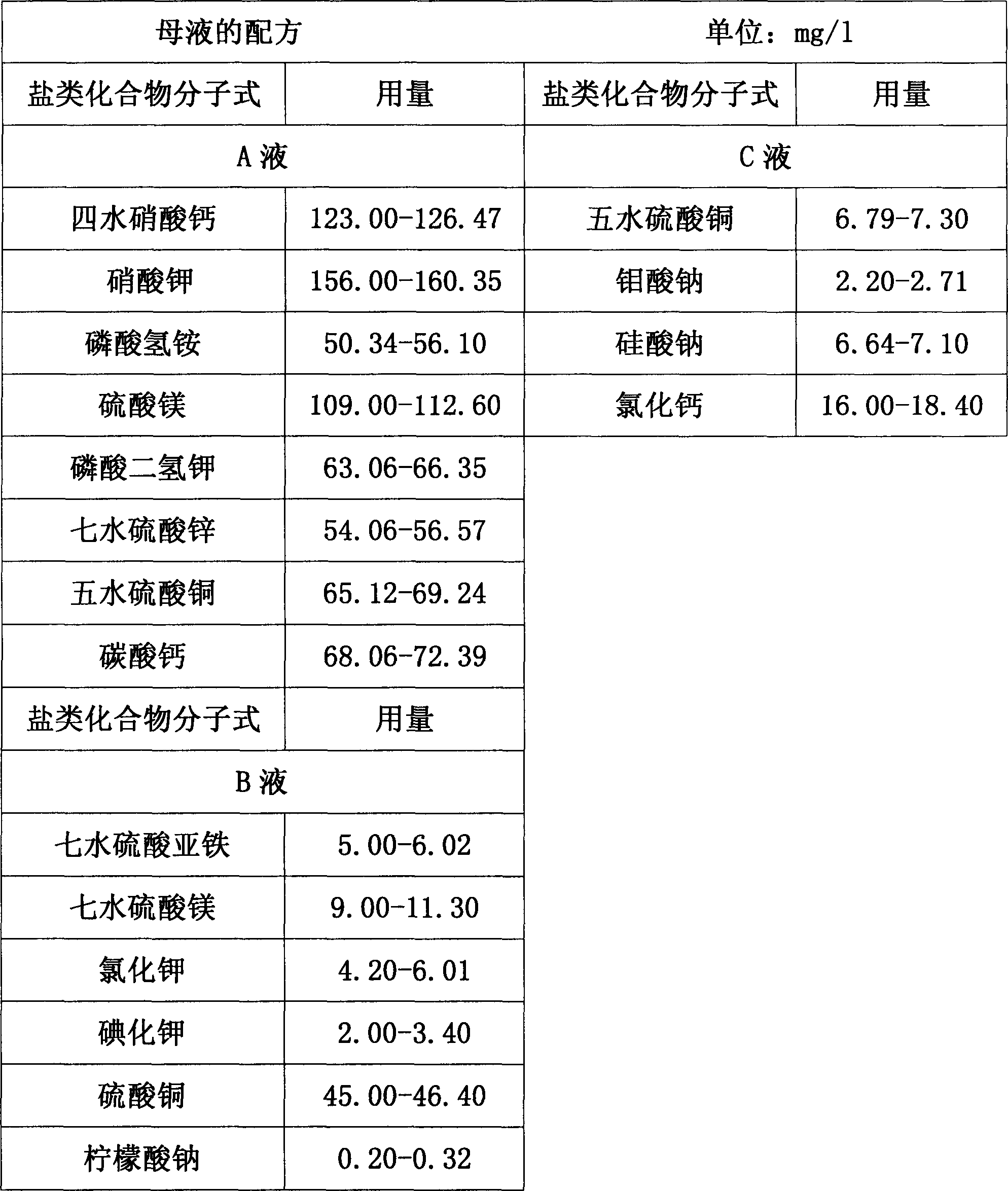Aloe hydroponic nutrient solution ingredient
A technology of nutrient solution and aloe vera water, applied in fertilizer mixtures, fertilization devices, applications, etc., can solve problems such as nutrient imbalance, and achieve the effects of speeding up the growth cycle, enhancing ornamental quality, and formulating scientifically.
- Summary
- Abstract
- Description
- Claims
- Application Information
AI Technical Summary
Problems solved by technology
Method used
Image
Examples
Embodiment 1
[0012] The main components of each 1000ml of liquid A are calcium nitrate tetrahydrate 123.00mg, potassium nitrate 156.00mg, ammonium hydrogen phosphate 50.34-56.10mg, magnesium sulfate 109.00mg, potassium dihydrogen phosphate 63.06mg, zinc sulfate heptahydrate 54.06mg, copper sulfate pentahydrate 65.12mg and calcium carbonate 68.06mg; the main components of each 1000ml of liquid B are 5.00mg of ferrous sulfate heptahydrate, 9.00mg of magnesium sulfate heptahydrate, 4.20mg of potassium chloride, 2.00mg of potassium iodide, 45.00mg of copper sulfate, and 0.20mg of sodium citrate The main components of every 1000ml of liquid C are 6.79mg of copper sulfate pentahydrate, 2.20mg of sodium molybdate, 6.64mg of sodium silicate, and 16.00mg of calcium chloride.
Embodiment 2
[0014] The main components of each 1000ml of liquid A are calcium nitrate tetrahydrate 126.47mg, potassium nitrate 160.35mg, ammonium hydrogen phosphate 56.10mg, magnesium sulfate 112.60mg, potassium dihydrogen phosphate 66.35mg, zinc sulfate heptahydrate 56.57mg, copper sulfate pentahydrate 69.24mg and calcium carbonate 72.39mg; the main components of each 1000ml of liquid B are 6.02mg of ferrous sulfate heptahydrate, 11.30mg of magnesium sulfate heptahydrate, 6.01mg of potassium chloride, 3.40mg of potassium iodide, 46.40mg of copper sulfate, and 0.32mg of sodium citrate; The main components of 1000ml of liquid C are 7.30mg of copper sulfate pentahydrate, 2.71mg of sodium molybdate, 7.10mg of sodium silicate, and 18.40mg of calcium chloride.
Embodiment 3
[0016] The main components of each 1000ml of liquid A are calcium nitrate tetrahydrate 125.47mg, potassium nitrate 158.35mg, ammonium hydrogen phosphate 53.10mg, magnesium sulfate 110.60mg, potassium dihydrogen phosphate 65.35mg, zinc sulfate heptahydrate 55.57mg, copper sulfate pentahydrate 67.24mg and calcium carbonate 70.39mg; the main components of each 1000ml of liquid B are 5.0mg of ferrous sulfate heptahydrate, 10.00mg of magnesium sulfate heptahydrate, 5.01mg of potassium chloride, 2.40mg of potassium iodide, 45.40mg of copper sulfate, and 0.20mg of sodium citrate; The main components of 1000ml of liquid C are 6.30mg of copper sulfate pentahydrate, 2.50mg of sodium molybdate, 7.32mg of sodium silicate, and 17.40mg of calcium chloride.
[0017] Described experimental group (embodiment 1, embodiment 2, embodiment 3) selects the aloe plant of identical size and shape, they are placed in identical suitable environment and cultivate one month, record the growth situation of ...
PUM
 Login to View More
Login to View More Abstract
Description
Claims
Application Information
 Login to View More
Login to View More - R&D
- Intellectual Property
- Life Sciences
- Materials
- Tech Scout
- Unparalleled Data Quality
- Higher Quality Content
- 60% Fewer Hallucinations
Browse by: Latest US Patents, China's latest patents, Technical Efficacy Thesaurus, Application Domain, Technology Topic, Popular Technical Reports.
© 2025 PatSnap. All rights reserved.Legal|Privacy policy|Modern Slavery Act Transparency Statement|Sitemap|About US| Contact US: help@patsnap.com



